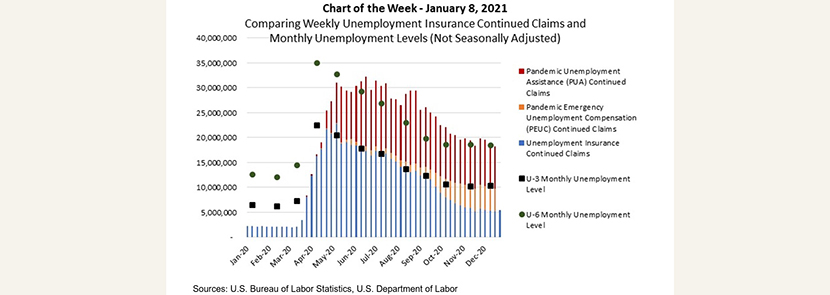
MBA Chart of the Week Oct. 11, 2021–Monthly Payroll Growth

Friday’s Employment Situation Summary from the U.S. Bureau of Labor Statistics indicated that job growth remained lackluster in September following similarly disappointing gains in August. Overall, the economy added 194,000 jobs in September, the weakest month thus far in 2021, but there were upward revisions to the previous two months’ totals. The average to date is 561,000 jobs added per month.
Although private sector job growth was at 317,000, government hiring dropped by 123,000 jobs. This drop was driven by education employment and was a byproduct of school hiring still being relatively weak compared to the typical seasonal patterns. The leisure and hospitality sector, a large segment of the economy still trailing during the current recovery, continued to show payroll growth – but at a slower pace over the past two months. This is the result of a combination of employers having difficulty filling open positions and weakness in bars and restaurants as COVID-related concerns reemerge.
The household survey showed a stronger, 526,000 increase in employment in September, indicating that the payroll survey may not be capturing all the recent employment gains in the economy. Additionally, the unemployment rate improved for the third consecutive month to 4.8 percent, edging back closer to the 3.7 percent rate average of 2019. With 7.7 million people unemployed and looking for work, and a record 10.9 million job openings, we expect the unemployment rate will continue to drop over the next year. There was also a further decline in workers who are long-term unemployed, although they still account for 35% of unemployed workers, compared to around 20% in the 12 months leading up to the pandemic.
The ongoing decline in the unemployment rate and the rise in wage growth, which increased at a 4.6% rate compared to September 2020, is good news for the housing market, as it will continue to support strong housing demand. The drop in the unemployment rate below 5%, and the other indicators of job market strength, are likely to be sufficient for the Federal Reserve to move forward with tapering their asset purchases. This will likely lead to modest increases in interest rates, putting additional pressure on housing affordability at a time home-price appreciation is still very high.
- Mike Fratantoni (mfratantoni@mba.org) , Joel Kan (jkan@mba.org)
